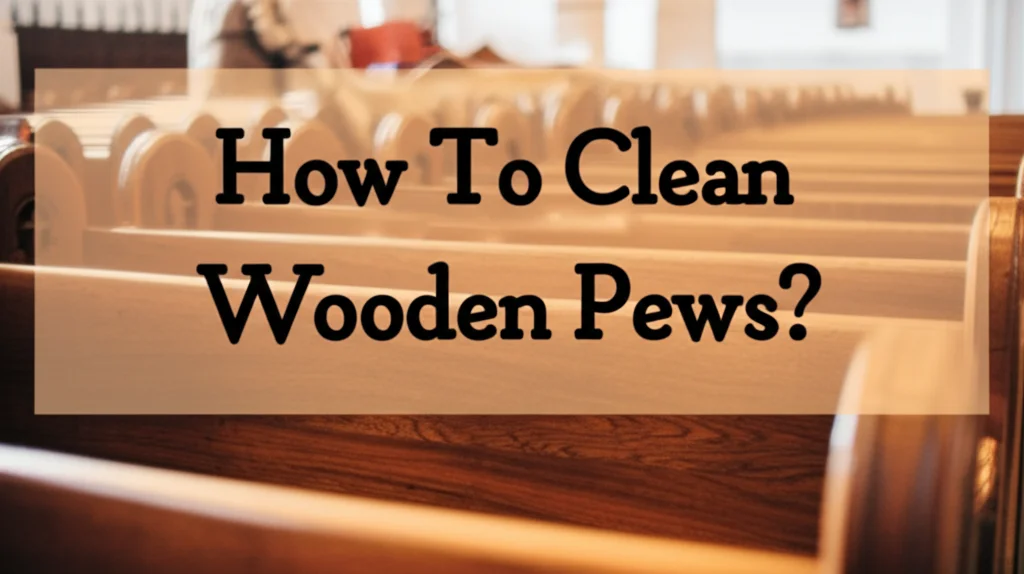· Church Cleaning · 7 min read
How To Clean Wooden Pews?

Keeping Faith with Your Furniture: How to Clean Wooden Pews?
Have you ever walked into a beautiful church and admired the rich, warm glow of the wooden pews? These aren’t just seating; they’re a part of the building’s history and a testament to craftsmanship. Maintaining their beauty requires regular cleaning, but knowing how to clean wooden pews properly is crucial. Incorrect methods can damage the wood, stripping away its finish and leaving it vulnerable to further wear. This article will guide you through everything you need to know, from simple dusting routines to tackling more challenging stains, ensuring your pews remain a welcoming and beautiful part of your place of worship for years to come. We’ll cover the best cleaning solutions, techniques, and preventative measures to keep your wooden pews looking their best.
Quick Answer: To clean wooden pews, regularly dust with a soft cloth, vacuum crevices, and occasionally use a mild wood cleaner diluted in water. Avoid harsh chemicals and abrasive scrubbers to protect the finish.
Takeaway: Consistent, gentle cleaning is key to preserving the beauty and integrity of your wooden pews.
Understanding Your Pew’s Finish
Before you begin, it’s important to identify the type of finish on your wooden pews. Different finishes require different cleaning approaches. Knowing what you’re dealing with will prevent damage and ensure the best results. Common finishes include varnish, lacquer, shellac, and wax.
- Varnish: This is a durable, glossy finish that’s relatively water-resistant. It can withstand gentle cleaning with mild soap and water.
- Lacquer: Similar to varnish, lacquer provides a protective coating but is more prone to damage from alcohol and harsh chemicals.
- Shellac: A traditional finish known for its warm tone, shellac is sensitive to water and alcohol. Dry cleaning methods are best.
- Wax: Wax provides a soft sheen and requires regular polishing to maintain its protection. Avoid water-based cleaners.
If you’re unsure of the finish, test a small, inconspicuous area with a mild cleaner before proceeding. A simple test can save you from costly repairs.
The Daily & Weekly Routine: Dusting and Vacuuming
Regular dusting and vacuuming are the cornerstones of pew maintenance. These simple tasks prevent dirt and grime from building up, which can dull the finish and cause scratches. Think of it as preventative care for your pews.
- Dusting: Use a soft, lint-free cloth to dust the pews at least once a week. Microfiber cloths are excellent for this purpose. Follow the grain of the wood to avoid scratches.
- Vacuuming: Vacuum the crevices and carvings of the pews with a soft brush attachment. This removes dust and debris that dusting alone can’t reach. Pay attention to areas where people sit and touch the pews.
- Frequency: In high-traffic areas, consider dusting and vacuuming more frequently, perhaps even daily. This will significantly reduce the need for more intensive cleaning.
Deep Cleaning Wooden Pews: A Step-by-Step Guide
When dusting and vacuuming aren’t enough, it’s time for a deeper clean. This involves using a mild cleaning solution to remove stubborn dirt and grime. Remember to always test the solution in an inconspicuous area first!
- Prepare the Solution: Mix a few drops of mild dish soap with warm water. Avoid using harsh detergents or abrasive cleaners.
- Apply the Solution: Dampen a soft cloth with the cleaning solution. Wring out the cloth thoroughly so it’s not dripping wet.
- Clean the Pew: Gently wipe the pew, following the grain of the wood. Avoid applying excessive pressure.
- Rinse: Dampen a clean cloth with plain water and wipe the pew to remove any soap residue.
- Dry: Dry the pew immediately with a clean, dry cloth. Leaving water on the wood can cause damage.
For more detailed cleaning, consider using a wood cleaner specifically designed for finished wood. You can find these at most hardware stores. Always follow the manufacturer’s instructions. If you’re looking for ways to clean other surfaces, you might find this article on https://www.beacleaner.com/how-to-clean-vinyl-plank-flooring/ helpful for other areas of the church.
Tackling Stubborn Stains on Wooden Pews
Sometimes, despite your best efforts, stains appear. Addressing these promptly is key to preventing them from becoming permanent. Different stains require different approaches.
- Water Rings: Try rubbing the ring gently with a soft cloth and a small amount of mayonnaise. Let it sit for a few minutes, then wipe clean.
- Ink Marks: Dab the ink mark with a cotton swab dipped in rubbing alcohol. Wipe gently and dry immediately.
- Gum: Harden the gum with ice, then carefully scrape it off with a plastic scraper.
- Grease: Apply a paste of baking soda and water to the grease stain. Let it sit for a few minutes, then wipe clean.
For particularly stubborn stains, you may need to consult a professional furniture restorer. They have the expertise and tools to safely remove stains without damaging the wood.
Protecting Your Pews: Polishing and Waxing
Polishing and waxing add an extra layer of protection to your wooden pews, enhancing their beauty and extending their lifespan. These treatments help to repel water and dirt, making cleaning easier.
- Polishing: Use a high-quality wood polish specifically designed for your pew’s finish. Apply the polish according to the manufacturer’s instructions.
- Waxing: Waxing provides a more durable protective coating. Apply a thin coat of paste wax with a soft cloth, following the grain of the wood. Let it dry, then buff to a shine.
- Frequency: Polish your pews every few months, and wax them once or twice a year. Regular polishing and waxing will keep your pews looking their best.
Preventing Future Damage: Best Practices
Prevention is always better than cure. Implementing a few simple practices can significantly reduce the need for extensive cleaning and repairs.
- Protect from Sunlight: Prolonged exposure to sunlight can fade the finish on your pews. Use curtains or blinds to shield them from direct sunlight.
- Control Humidity: Fluctuations in humidity can cause the wood to expand and contract, leading to cracks and warping. Maintain a consistent humidity level in the church.
- Avoid Abrasive Cleaners: Never use abrasive cleaners or scrubbers on your wooden pews. These can scratch the finish and damage the wood.
- Promptly Address Spills: Clean up spills immediately to prevent them from staining the wood.
If you’re dealing with other cleaning challenges, you might find this article on https://www.beacleaner.com/how-to-clean-hardwood-floors-with-vinegar/ helpful for other wood surfaces in your church.
Frequently Asked Questions (FAQs)
Q: Can I use vinegar to clean my wooden pews? A: While diluted vinegar can be used on some wood finishes, it’s generally not recommended for wooden pews. Vinegar is acidic and can damage certain finishes like shellac or wax. It’s best to stick to mild dish soap and water or a wood cleaner specifically designed for finished wood.
Q: How often should I professionally clean my wooden pews? A: Professionally cleaning your wooden pews every 2-5 years is a good practice, depending on usage and wear. A professional can assess the finish and perform more intensive cleaning and restoration if needed.
Q: What’s the best way to remove old wax buildup from my pews? A: Mineral spirits can effectively remove old wax buildup. Apply a small amount to a soft cloth and gently wipe the surface. Always test in an inconspicuous area first and ensure good ventilation.
Q: Can I use a steam cleaner on wooden pews? A: No, avoid using a steam cleaner on wooden pews. The heat and moisture can damage the wood and the finish, potentially causing warping or cracking.
Q: What should I do if I notice mold growing on my wooden pews? A: Mold indicates a moisture problem. Address the source of the moisture first. Then, gently clean the mold with a solution of mild bleach and water (1 part bleach to 10 parts water). Wear gloves and a mask, and ensure good ventilation.
Preserving a Legacy: The Importance of Pew Care
Cleaning wooden pews isn’t just about aesthetics; it’s about preserving a piece of history and honoring the craftsmanship that went into creating them. By following these simple guidelines, you can ensure that your pews remain a beautiful and welcoming part of your place of worship for generations to come. Remember, consistent, gentle care is the key to maintaining their beauty and integrity. Taking the time to properly clean and protect your wooden pews is an investment in the future of your church and a testament to your commitment to preserving its legacy. If you’re looking for more cleaning tips, check out this article on https://www.beacleaner.com/how-to-remove-mold-from-painted-walls/ for dealing with other potential issues in your church building.
- wood pew cleaning
- church maintenance
- pew restoration




